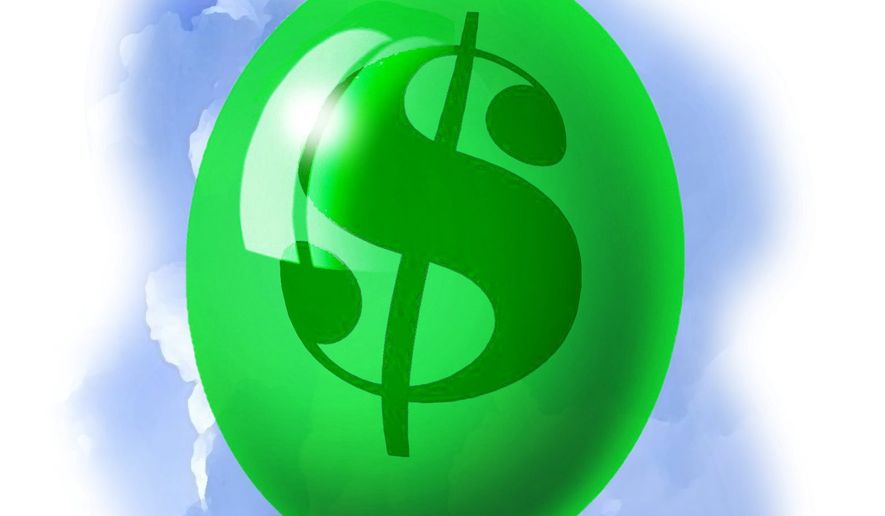OPINION:
Austrian economist Ludwig von Mises referred to inflation simply as an increase in money and credit. By this definition, inflation has arrived — at least in the short term — brought on in large part by the unprecedented federal spending masked as a response to COVID-19.
Much of this inflation has been in asset prices – stocks and houses – but it’s now becoming clear that prices of consumer goods and services are on the rise as well.
As if severe labor shortages and the prospect of skyrocketing taxes weren’t enough, small business owners (who provide the majority of new jobs) are now dealing with the effects of this inflation. Restaurants will be acutely impacted by these trends cutting across our economy, as higher labor and food costs put pressure on already thin margins.
Inflation reduces the value and purchasing power of every dollar, making everything more expensive. In May, America’s annual inflation rate reached 5 percent, its highest level since August 2008. The Federal Reserve insists that the significant increase in inflation is “transitory.” Given the numerous supply chain disruptions that occurred across the world due to COVID-19 restrictions in 2020, this may be true. But considering the current administration’s economic agenda, it’s likely that inflation won’t go away in the short term.
Fortunately, at this moment, the restaurant industry is healthier than it was in 2020. The American people are coming out of lockdowns and are eager to go out and eat and spend time and money. But that party may not last forever. Home delivery, for example, was enhanced during COVID-19 as people spent more time working at home and had extra stimulus money. Those same home delivery businesses are now possibly faced with a double whammy of more competition as COVID-19 restrictions vanish, and juiced-up unemployment benefits make it harder for them to hire and retain employees. If the customers’ wages can’t keep pace with sharply rising prices, the restaurant industry, including the pizza delivery business, will feel the pain.
Kraft Heinz CEO Miguel Patricio said his company is “very concerned” about the drastic rise in inflation and looking at the possibility of increasing prices for consumers. You can almost guarantee that every restaurant owner in the country is facing the same difficult choice.
Think about it. If inflation continues to increase, the costs for raw ingredients and supplies will continue to increase right along with it. It’s only a matter of time before restaurants further increase their prices to consumers. The fact that the labor shortage is also forcing many businesses to raise wages to court a dwindling supply of potential employees all but guarantees a callous choice – raise prices at the counter or potentially go out of business.
But inflation (printing money) doesn’t just raise the cost of food — it devalues the dollar – a hidden tax on everyone as it raises the cost of everything. As families are faced with increasing costs of utility bills, groceries, gas, and household essentials, they will be increasingly less likely to spend on “extras.”
All of this is particularly tough for the pizza delivery business model. Imagine you own a pizzeria. Not only are the costs of your raw ingredients rising, from flour and salt to tomatoes and mozzarella, but gas is more expensive too, as are employees. On top of that, inflation starts to wallop your customers, and those families that ordered at least once a week start ordering every other week. And then just once a month.
Unfortunately, the Biden administration isn’t focused on getting inflation under control — and could make it even worse. The Congressional Budget Office projects trillion-dollar deficits as far as the eye can see (and a $2+ trillion deficit for 2021). Biden also proposed an over $2 trillion infrastructure package and wants to make some COVID-level welfare payments permanently. These deficits will likely be funded by the creation of additional dollars by the Federal Reserve – “money printing” – which will continue to devalue the dollar and possibly create additional inflationary pressures into the foreseeable future. In addition to inflation hitting consumers in the pocketbook, inevitable higher taxes will also take a toll as businesses look for ways to pass those additional taxes to their customers, just as they would any other increased cost.
Rapidly rising costs coupled with a severe decline in customer base isn’t sustainable for any business. If something doesn’t change soon, these dynamics will result in significant headwinds for the great small business owners of America and family restaurants struggling to get back on their feet.
Inflation isn’t an act of God, nor is it a freak accident of nature. It is the result of inadvisable economic policies combined with unchangeable economic realities.
The Federal Reserve could be right — the recent rise in inflation is hopefully “transitory.” But if Washington doesn’t change its current plan to centralize its control over our lives further and pass record-high new taxes onto the American public, the negative impacts will affect small business owners, restaurants, and pizza companies alike.
As we watch this unprecedented spending and money printing continue, perhaps the best option is to go to the back of the boat, sit back, have a beverage, and enjoy the ride while it lasts! Most small business owners won’t have that luxury, though, which is why Washington should set a new course that better supports their survival.
• Papa John Schnatter is the founder and former Chairman and CEO of Papa John’s International (PZZA).




Please read our comment policy before commenting.